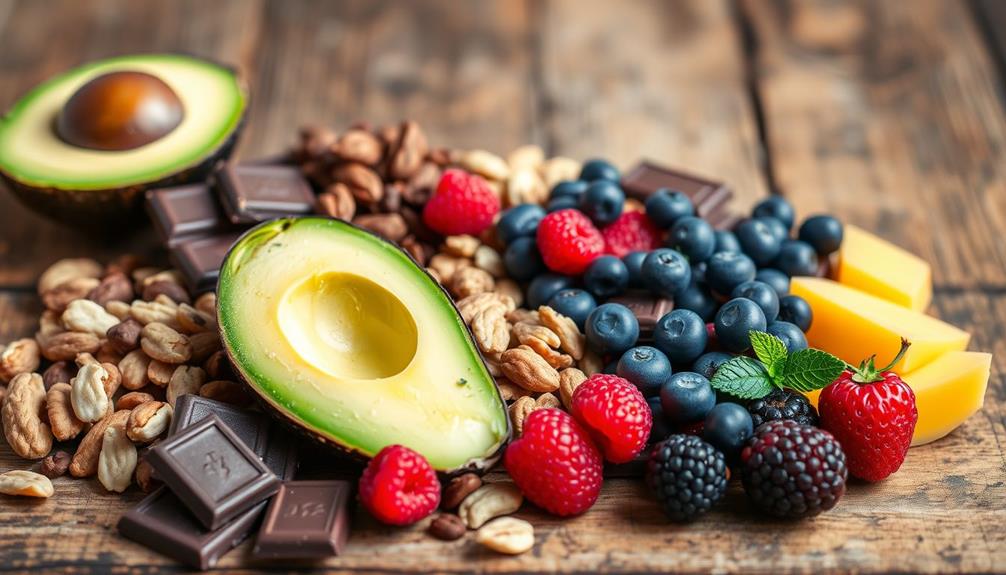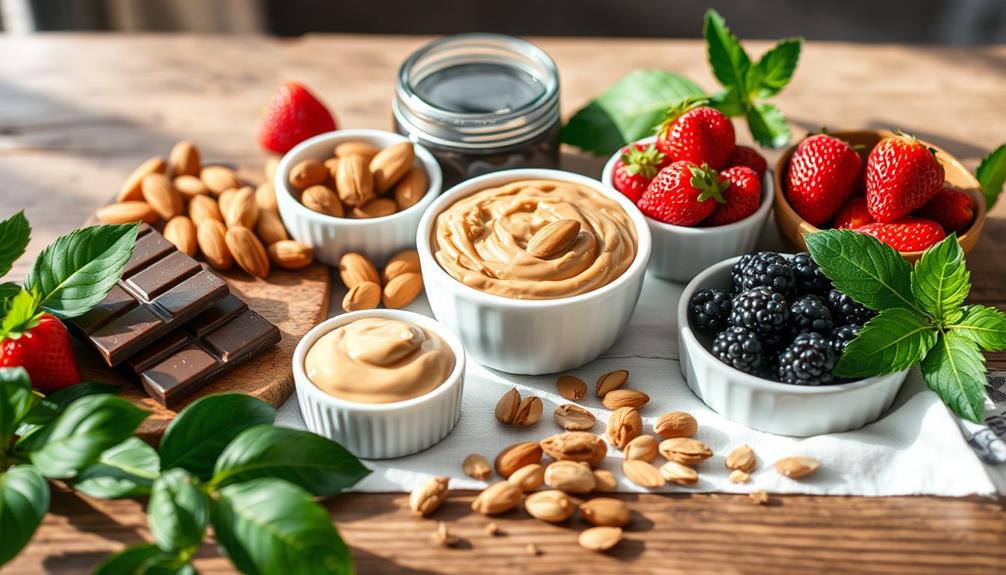You can conquer your cravings and achieve your weight loss goals with effective keto solutions. Start by focusing on low-carb snacks like cheese chips and nut butter, which help keep you full. Stay hydrated to manage hunger and reduce cravings. If you crave sugar, opt for low-sugar fruits like berries or try keto-friendly desserts. For carb cravings, zucchini noodles make a great substitute, while recognition of triggers can help you cope. Incorporating healthy fats and proteins is key. Embracing mindfulness and community support boosts your success. There's more to explore on how to keep those cravings at bay! Consider experimenting with ketofriendly mushroom recipes to add variety and satisfaction to your meals. Mushrooms are low in carbs and can be used as a base for a wide range of dishes, from stir-fries to stuffed mushrooms. They are also a good source of fiber and essential nutrients, making them a great addition to a keto-friendly diet. By exploring new recipes and staying committed to your goals, you can conquer your cravings and achieve lasting success on your weight loss journey.
Key Takeaways
- Incorporate low-carb snacks like cheese chips and nut butter to curb cravings and keep you satisfied.
- Stay hydrated to reduce hunger feelings and combat cravings effectively.
- Utilize low-sugar fruits, such as berries, to satisfy sweet cravings in a keto-friendly way.
- Plan meals in advance to avoid impulsive eating and recognize triggers for better coping strategies.
- Engage in mindfulness techniques, such as deep breathing, to help manage cravings and emotional triggers.
The Basics of the Keto Diet

The keto diet, often referred to as the ketogenic diet, is a low-carb, high-fat eating plan designed to shift your metabolism into a state of ketosis.
By drastically reducing carbohydrate intake, your body begins to burn fat for energy instead of glucose. This metabolic shift not only aids in weight loss but also enhances insulin sensitivity and improves blood sugar control.
To succeed on the keto diet, you'll need to focus on foods rich in healthy fats, such as avocados, nuts, and olive oil, while avoiding sugar and starchy foods.
Understanding how this dietary approach works can help you navigate the initial challenges, making it easier to stick to your goals and enjoy the benefits of improved health and well-being.
Identifying Common Cravings

Understanding the keto diet lays the groundwork for recognizing the cravings that may pop up as you adjust to this new way of eating.
You might find yourself craving sugar, carbs, or salty snacks, especially in the beginning. These cravings often stem from blood sugar fluctuations or emotional triggers, making it essential to pinpoint their roots.
For instance, sugar cravings can arise from past habits or a drop in energy levels. Carb cravings might be linked to psychological triggers, while salt cravings can signal a need for electrolyte balance.
Strategies for Managing Cravings

Managing cravings on the keto diet can feel challenging, but having effective strategies in place makes it much easier. Here are some techniques to help you stay on track:
- Incorporate low-carb snacks like cheese chips, nut butter, and keto-friendly desserts to satisfy cravings.
- Focus on healthy fats and protein—foods like olive oil, eggs, and Greek yogurt promote fullness and curb hunger pangs.
- Stay hydrated; drinking plenty of water can help reduce feelings of hunger and cravings.
- Utilize distraction techniques—engage in activities like reading, walking, or hobbies to divert your mind from cravings.
Solutions for Sugar Cravings

Craving sugar on a keto diet can feel overwhelming, especially during the initial shift when your body adjusts to lower carb intake.
To tackle those sugar cravings, try incorporating low-sugar fruits like berries into your meals. They provide a sweet taste without the high carb load. You can also whip up some keto-friendly desserts, such as avocado chocolate mousse, which can satisfy your sweet tooth without derailing your diet.
Additionally, focus on healthy fats and proteins to keep you full; options like nut butter or Greek yogurt can help.
Remember, it's important to stay hydrated and engage in mindful eating to distinguish between true hunger and sugar cravings.
With these solutions, you can conquer your cravings and stick to your keto lifestyle.
Overcoming Carb Cravings

Carb cravings can be a formidable challenge on your keto journey, often leading you to reach for energy-dense, high-carb foods.
To overcome these cravings, you need to recognize your triggers and have a plan in place. Here are some effective strategies to help you stay on track:
- Opt for low-carb substitutes like zucchini noodles instead of pasta.
- Snack on nuts or cheese to keep your hunger at bay.
- Stay hydrated; sometimes cravings stem from dehydration.
- Plan your meals and snacks to avoid impulsive decisions.
Addressing Salt Cravings

During your keto journey, you might find yourself reaching for salty snacks more often than usual. This craving often signals a need for electrolyte balance, especially sodium.
To address it, start by ensuring you're well-hydrated, as dehydration can amplify these urges. Incorporate foods rich in electrolytes, like salted nuts, olives, or pickles, to satisfy your cravings while staying on track.
Adding a pinch of sea salt to your meals can enhance flavor and help maintain balance. If cravings persist, consider tracking your salt intake and adjusting your diet accordingly.
Embracing Support and Mindfulness

Finding balance in your keto journey goes beyond just managing cravings; it also involves embracing support and practicing mindfulness. Surrounding yourself with a supportive community can keep you motivated and accountable.
Additionally, mindfulness techniques can help you recognize emotional triggers and make healthier choices. Here are some strategies to contemplate:
- Join a keto support group, either online or in person.
- Practice deep breathing or meditation to increase self-awareness.
- Keep a food journal to track your cravings and emotions.
- Plan meals ahead to reduce stress and improve adherence.
Frequently Asked Questions
Can I Combine Keto With Other Diets Effectively?
You can combine keto with other diets effectively by choosing compatible principles, like focusing on whole foods and healthy fats. Just be mindful of macronutrient ratios to guarantee you still meet your keto goals.
How Long Does It Take to Adapt to a Keto Diet?
It usually takes you about two to four weeks to fully adapt to a keto diet. During this time, your body shifts from burning carbs to burning fat, which can cause temporary fatigue and cravings.
Are There Any Keto-Friendly Alcoholic Beverages?
Yes, you can enjoy keto-friendly alcoholic beverages! Opt for dry wines, spirits like vodka or gin, and sugar-free mixers. Just remember to drink in moderation, as alcohol can affect your ketone levels and cravings.
What Should I Do if I Stall on My Weight Loss?
If you think stalling means failure, you're mistaken. Reassess your portion sizes, increase physical activity, and guarantee you're staying hydrated. Sometimes, small adjustments can reignite your weight loss journey and keep you motivated.
How Can I Maintain Keto While Traveling or Dining Out?
When you travel or dine out, plan ahead. Research menus, choose low-carb options, and don't hesitate to ask for modifications. Staying hydrated and bringing snacks can help you stick to your keto goals effortlessly.
Conclusion
So, as you march through your keto battlefield, armed with avocados and cheese sticks, remember that cravings are just sneaky little gremlins trying to derail your mission. Picture them in tiny capes, begging for sugar and carbs as you wave your low-carb snacks like a victorious flag. By using the strategies we've covered, you'll not only conquer these pesky cravings but also emerge as the heroic keto warrior you were destined to be. Onward, to delicious triumph!









